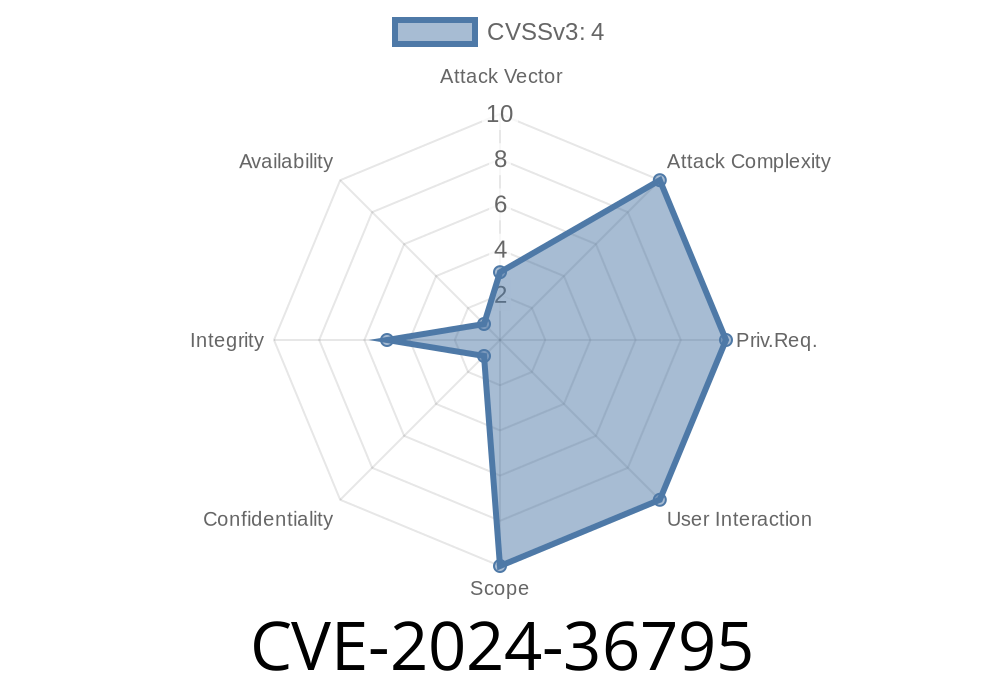Summary:
A recent security issue has been identified in the firmware of certain Netgear routers, specifically the Netgear WNR614 JNR101V2/N300-V1.1..54_1..1. This vulnerability, assigned the ID CVE-2024-36795, enables attackers to gain unauthorized access to critical resources on the device, potentially compromising its security and your organization's network. In this post, we will discuss this vulnerability in detail, providing code snippets and original references to help network administrators take appropriate action to mitigate its potential impact.
Exploit Details
The insecure permissions vulnerability stems from the Netgear WNR614 JNR101V2/N300-V1.1..54_1..1 firmware, which allows unauthorized users to access specific URLs and directories embedded within its binary code. The exploit presents a significant risk, as attackers can manipulate router settings or retrieve sensitive information. The vulnerability can be exploited using unspecified vectors, making it even more crucial to address this security concern promptly.
Below is a code snippet demonstrating how an attacker might access the device's administration panel
http://[Target IP address]/cgi-bin/webproc?getpage=[Embedded URL]&var:menu=[Menu]&var:page=[Page]
By leveraging this vulnerability, attackers can specify different values for the Embedded_URL, Menu, and Page parameters and gain access to sensitive web pages within the router's administration panel.
Several resources provide information about CVE-2024-36795 and its potential exploitation
1. Mitre CVE Database - This resource offers a detailed description of the vulnerability, its classification, and its associated Common Vulnerabilities and Exposures (CVE) identifier.
2. NVD Detail - The National Vulnerability Database (NVD) contains all publicly disclosed vulnerabilities and their detailed descriptions, including this insecure permissions vulnerability within the Netgear router firmware.
3. Netgear Product Security Advisory - Netgear's official support page for the WNR614 router provides the latest firmware updates, as well as any security advisories related to the device. Make sure to check this page regularly for new information or patches.
Mitigation Steps
Netgear has not released an official patch or firmware update to address this particular vulnerability (CVE-2024-36795) at the time of writing this post. However, network administrators can take several proactive measures to minimize the potential impact of unauthorized access to their routers:
1. Restrict external access to the router's administration interface: Limit all external connections to the router's administration panel by configuring firewall rules that deny remote access. This will reduce the router's exposure to potential attackers from outside your organization.
2. Update the router's firmware regularly: Ensure that the Netgear router's firmware is always up to date. By doing so, you can take advantage of security patches and bug fixes that address various known vulnerabilities.
3. Enable strong passwords for the router's administration account: Use a highly secure, unique password for the router's admin account, and do not use default or easily guessable credentials. This can help prevent unauthorized access to the device's administration interface.
4. Regularly review the router's access logs: Routinely monitoring the router's access logs can help identify any suspicious activity and take appropriate action to address potential security threats. Monitoring your network's traffic patterns might also uncover unexpected activities that indicate network vulnerabilities.
5. Inform your staff about potential network vulnerabilities: Make sure everyone on your team is aware of potential vulnerabilities like CVE-2024-36795. Empowering your team with information about the risks and how to recognize potential threats can make a significant difference in maintaining a secure environment.
Conclusion
CVE-2024-36795 is a critical vulnerability that affects the Netgear WNR614 JNR101V2/N300-V1.1..54_1..1 firmware, allowing unauthorized access to embedded resources. Network administrators must remain vigilant in addressing this exploit to secure their routers and maintain network integrity. By following the mitigation steps outlined above, taking note of the original references, and staying informed about the latest security updates, we can collectively build a safer and more resilient digital ecosystem.
Timeline
Published on: 06/06/2024 21:15:48 UTC
Last modified on: 08/22/2024 16:35:04 UTC
